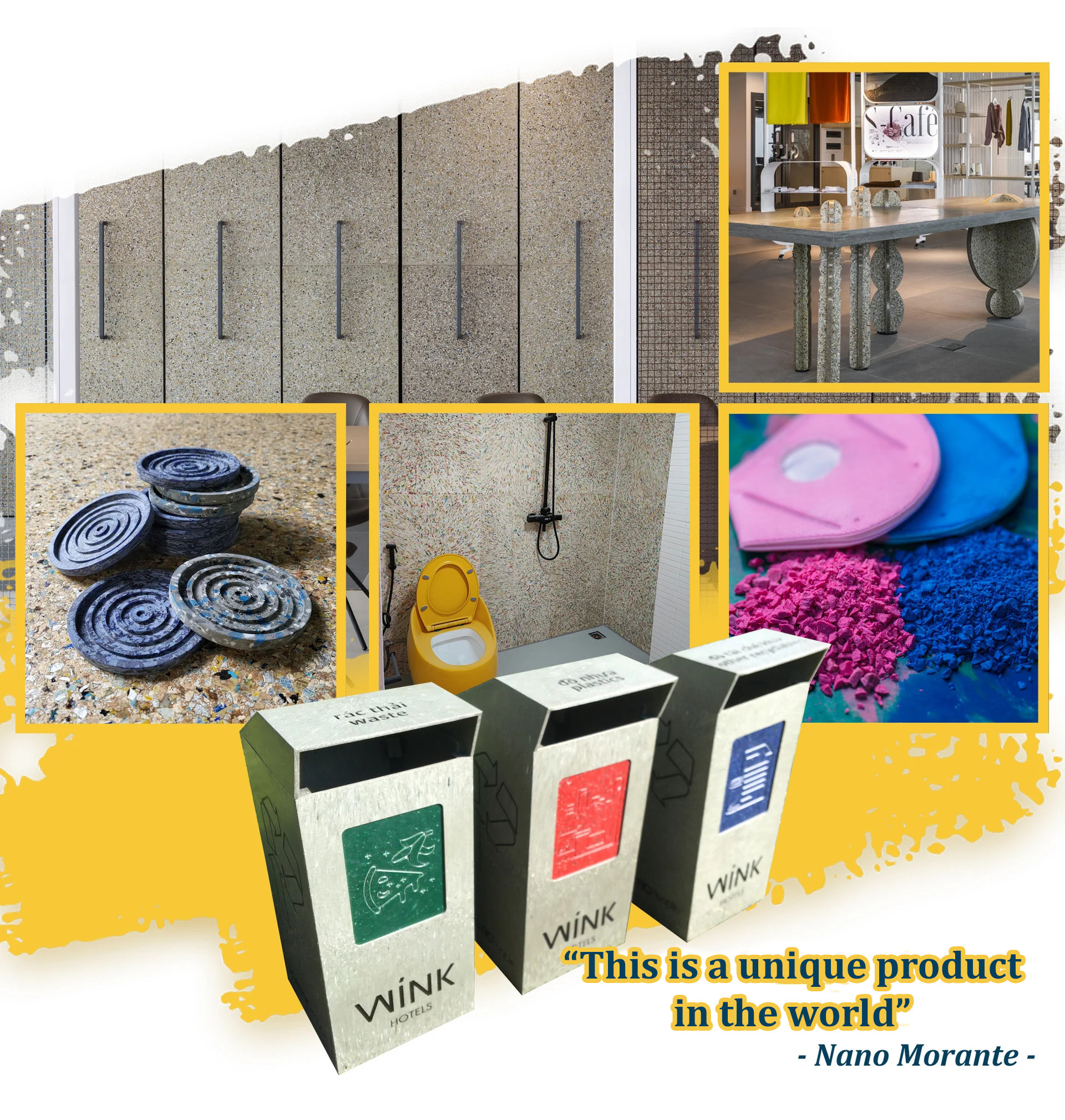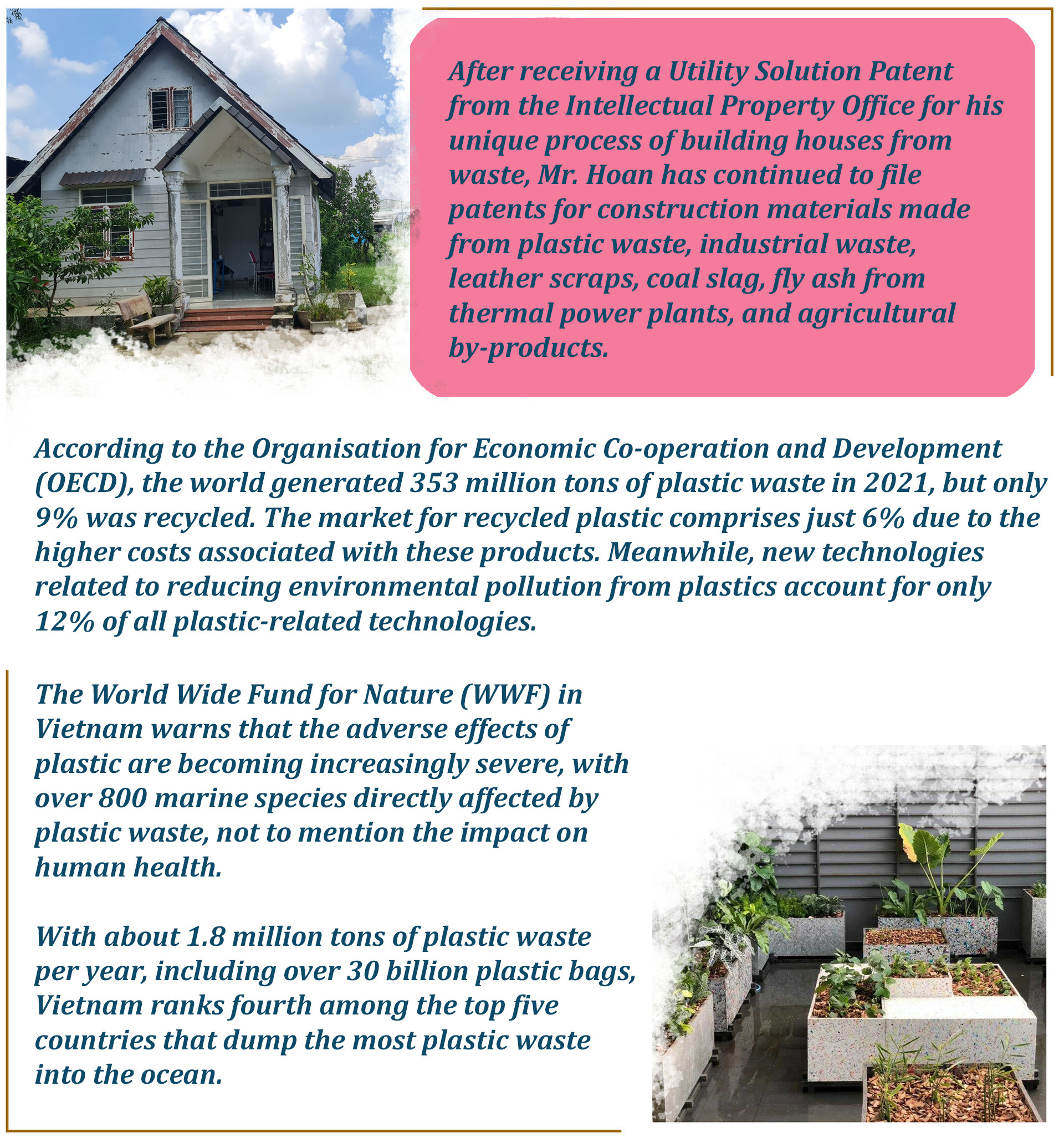

Earning money is a hard slog. However, rather than working for others, one can profit from discarded items. It is quite remarkable that what would have ended up in your trash yesterday, potentially polluting the oceans, could today be transformed into something useful. Trash, quite literally, can even become houses.
The "future rescuers" in this story were once labeled as "crazy," but they have demonstrated the seemingly impossible: turning waste into opportunity, into a "treasure."

Four years ago, Nestor Catalan, the founder of PLASTICPeople, left his advertising career in Spain to travel the world, pursuing his passion. Meanwhile, Nano Morante from Argentina had, since childhood, dreamt of changing the world and doing something different to connect people. When the two arrived in Vietnam, they met and conceived the idea for PLASTICPeople, inspired by mountains of waste.

"While working together, my colleagues and I strive to find solutions related to plastic, whether general or specific. Our ultimate goal is long-term sustainability. Specifically, we must source plastic waste, process it, develop methods to repurpose it, and most importantly, find markets and customers for these products. Without a market, there is no supply-demand cycle," Nano Morante enthusiastically explained.

Upon first meeting Nano and Nestor, we were captivated by their humor and openness. They spoke freely about what they observed and experienced, sharing their concerns about the unresolved global waste crisis. Instead of waiting for someone or some policy to act, we must change for a better future. This is the message Nano and Nestor aim to convey to the community.
The initial concept of PLASTICPeople involved recycling plastic waste collected from reliable sources like scrap dealers or from households and schools. Why PLASTICPeople? Nano and Nestor wanted solutions to plastic waste where humans are the users and improvers. A responsible cyclical relationship needed to be established:

Of course, initiating such a different idea was not easy. Nano was deemed "crazy" from the moment he shared this concept with others. Rather than feeling discouraged, this spurred him on to prove his boundless creativity.
Many prejudices and questions arose about what seemed like a vague concept: How could a business be started? How would operations be sustained, and how could finances be managed?
“My madness lies in not being content within a comfort zone. Sometimes, we need not pay attention to too many opinions. Be free to create and find the right partners. When you believe in your choice, put everything you have into it, make every effort, and have the ability to apply the idea to real life, then things can come to fruition,” Nano said.

From two machines for melting and pressing plastic, Nano and Nestor produced their first plastic sheets. Upon seeing the small, intricately patterned panels, no bigger than the palm of a hand, they could not contain their pride and happiness.
However, PLASTICPeople did not stop at creating small boards for mere amusement. They expanded their product line to include practical items such as coasters, utensil holders, flower pots, tabletops, and even entire houses and small construction projects. Remarkably, they even produce garbage bins made from waste.

Instead of solely processing common materials, PLASTICPeople accepts all types of plastic, including candy wrappers, foam boxes, straws, and surplus packaging from factories. Alongside innovating and developing recycled materials, they have perfected their communication methods and expanded their network of collaborators. This expansion aims to secure a steady supply of raw materials through partnerships with offices, residential complexes, schools, and cafés that share their environmental concerns.
"Because these products are made from plastic waste, we have to study and understand each type of plastic—whether it’s more rigid or safer—before we can manufacture products from them," Nano explained, holding up a plastic board for us to examine.
With one ton of plastic waste, PLASTICPeople can create a panel covering 15-20 square meters, taking approximately 15 days to complete. The pricing of the products depends on the type and quality of the materials used. Nano confidently claims these are unique products globally.

The founder of PLASTICPeople stated: “Anyone who sorts plastic waste at home can connect with us via Facebook. We have a guide on how to categorize waste at its source. People can send us their ‘trash,’ which we will recycle into astonishing masterpieces: roof tiles, home interiors, or café décor.
By joining forces, we can achieve change. And I must emphasize that I am not the person changing everything; I am merely a ‘facilitator,’ a ‘bridge’ for collective action and transformation.”
PLASTICPeople plans to open another factory in Hanoi by the end of this year, with future expansions planned for Phan Thiet, Phu Quoc, Cambodia, Nepal, and Thailand. These ambitious goals keep Nano and Nestor perpetually busy. The two men believe that each country they choose to venture into shares a common thread leading toward a better future.
Currently, PLASTICPeople has completed three social housing projects in the Mekong Delta and aims to reach 500 houses per year over the next decade.
Nano said: “I have no desire to be excessively wealthy; I only wish to cover my living expenses and pay my team members. We also have investors and generate revenue, but we are all aligned with a single goal: focusing on people and the community.”

Some customers are prejudiced against using items made from waste, but Nano insists these products are safe and have a lifespan of hundreds of years. PLASTICPeople guarantees a three-year warranty, allowing the plastic to undergo several recycling cycles. Esteemed partners of PLASTICPeople include Wink Hotels, Chocolate Marou, and Rice Creative.
“Plastic remains plastic, even after seven recycling cycles or any transformation; it is still plastic. I want to say that instead of discarding any type of plastic waste—or even the bricks and roof tiles we have recycled—if they get damaged, just bring them back to us. We can recycle them up to 25 times. Thus, they continue in a recycling loop, significantly reducing the environmental impact of plastic waste,” Nano explained.
Nano and his colleagues are not under the illusion that recycling will lead everyone to cease using plastic—“because plastic is an invention that is convenient and inexpensive,” Nano noted.
Yet, PLASTICPeople does more than offer design solutions or useful products. More importantly, they inspire change in public perception through community and school workshops.
PLASTICPeople does not only offer design solutions or useful products but, more importantly, inspires people to change their awareness.

The path leading to Mr. Phan Trong Hoan’s smart modular house in Hamlet 3, My Yen Commune, Ben Luc District, Long An Province, is littered entirely with… garbage. However, moving past the initial unsightliness, one is struck by the sight of a charming small house with a modern design, set on a lush green lawn.
A house constructed from what others discard: trash. Yes, trash.
The building materials for this house come from rice husks and plastic waste. Mr. Hoan used discarded waste to create construction materials for a house approximately 60 square meters in size, built in 2013. After years of use, the house remains solid and shows no signs of deterioration.
“I used 50% rice husks and 50% plastic waste to create the building material for the house. I spent several decades researching to develop this unique material, which, I can say, surpasses many materials currently on the market,” said Mr. Hoan.

Initially, Mr. Hoan challenged himself to work solely with plastic waste, but after extensive research, he discovered that various types of waste could be used to create building materials without the need for sorting.
The idea for this house originated from a work trip to the Mekong Delta many years ago: “During the trip, I was confronted by a river full of rice husks and garbage. This image sparked the idea of transforming these materials into construction materials as a replacement for traditional bricks and tiles. This approach not only helps protect the environment but also adds value, contributing to the development of a circular economy,” Mr. Hoan recounted.
Despite numerous failures, Mr. Hoan remained persistent and never gave up. His determination led to the creation of a construction material that can effectively replace others.

Apart from the garbage house in Long An, Mr. Hoan has built many other houses from this material in various provinces and cities.
Reflecting on his life, Mr. Hoan appears as an “extraordinary” character. Though in his seventies, his robust and energetic appearance belies his age, exuding a youthful zeal for his work.
“I sleep very little each day, driven by my passion for research, sometimes even forgetting to eat. Protecting the environment is not a task for a day but requires true persistence,” Mr. Phan Trong Hoan stated.


Mr. Hoan has faced health challenges, yet after recovering, he always returns with new product ideas: “Beyond houses made from waste materials, I am contemplating using recycled plastic to create sea dikes, floating houses, and offshore structures. We must repurpose waste into economically beneficial resources rather than mere garbage—a term people instinctively avoid,” he shared.
Discussing his philosophy, Mr. Hoan believes that starting a venture has no age limit. To him, waste is not just refuse but can be a treasure trove. Despite the challenges, Mr. Hoan continues his work and research, driven by the ongoing environmental issues that plague our world every day.


>>> The Future Rescuers (Part 1): Moments of Solitude and Doubt
---
Contributors:
- Story: Đào Thị Hồng Lĩnh
- Editorial Assistants: Minh Hiếu
- English: Đinh Phạm Trân
- Photography: Đỗ Ngọc Tuấn
- Video: Hồng Lĩnh - Dũng Lê
- Design: Nguyễn Quang Huy
